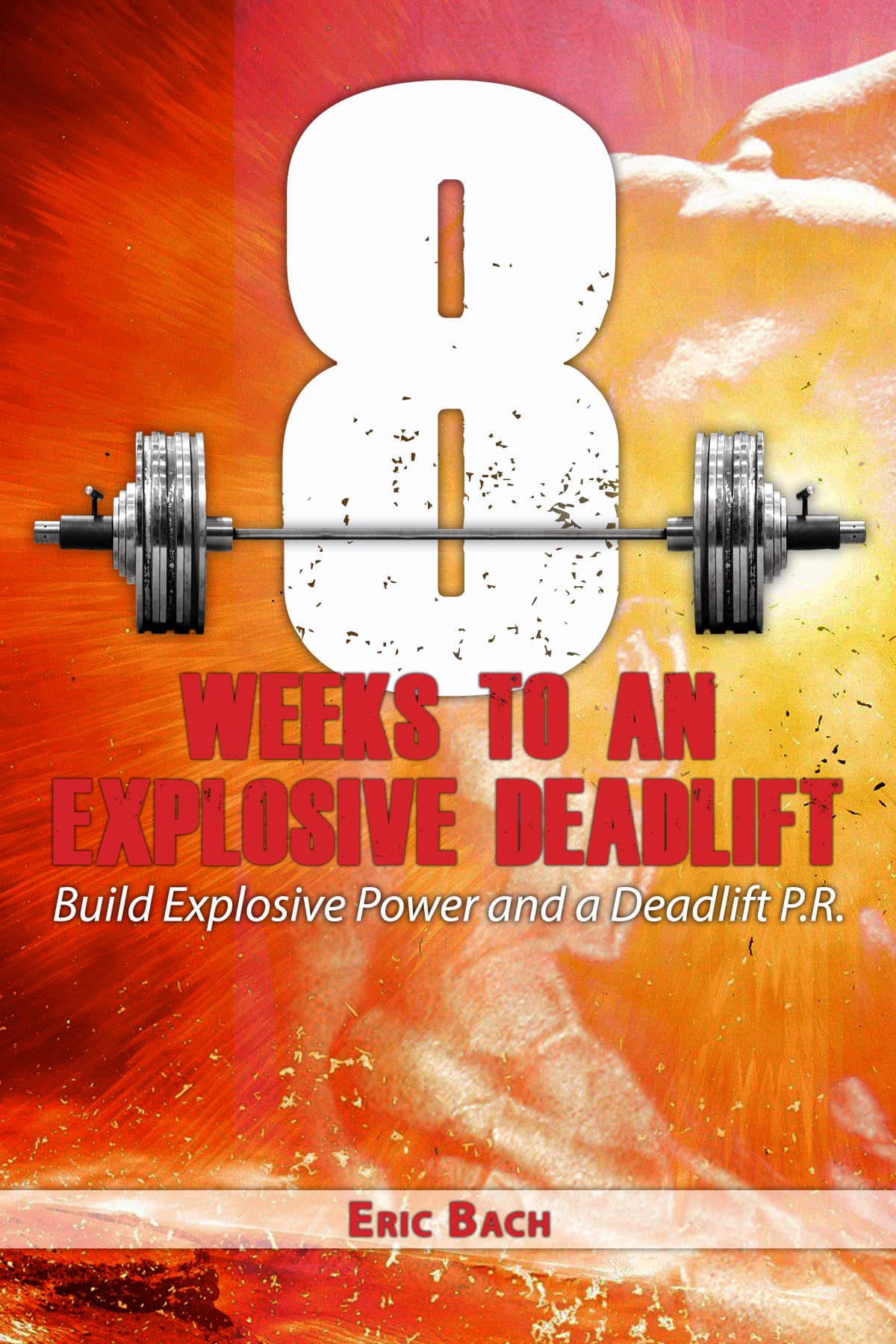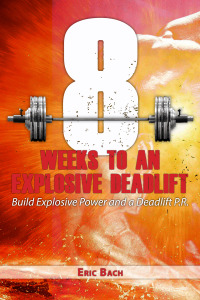10 Tips to An Explosive Deadlift
October 24, 2014
Deadlifts build epic strength.
Deadlifts get you jacked.
Deadlifts help you get athletic. Deadlifts require full body tension, strength, and sheer willpower to build strong bodies and stronger minds.
Deadlifts build a chiseled back, vice-grip forearms, and an athletic booty to grab the attention of both sexes. As such, the deadlift is the most cherished movements in training for helping you look better naked, be strong as an ox, and improve performance.
Yep, few things get your testosterone pumping and your manhood on like deadlifts, except maybe this steak recipe and watching Predator re-runs.
Perfect then..right? All you need to do is grip a barbell and rip it from the floor. .Well, no. For all the love deadlifts get most lifters either incorrectly program them or butcher them with such awful form they end up with porous strength numbers and debilitating back pain.
While I love deadlifts I try not to put any exercise on a pedestal—all exercises are a tool for a physiological response to help you improve performance, look better naked, or feel better–not an end all be all to training.
Like anything else, there’s a risk-reward for pushing your body to the limits. The deadlift is a great exercise, but you need intelligent planning to maximize your training without snapping your back in half like a toothpick.
The ten tips below from my eBook Eight Weeks to an Explosive Deadlift will help you boost your deadlift sky-rocket and reduce the chance of injury.
1.Pull the Bar Tight:
When the bar drifts away from your body you open a pandora’s box of issues: A greater tendency to round the back, increased shear stress on the spine, and a difficult position to finish the lift.
Unless you want to miss lifts and incur flexion based back injuries then use the lats to pull the bar tight to your shins. The lats connect your spine to your shoulder with tons of connection to the fascia in the low back. Pulling the tight both ensures a vertical bar path and further engages the core to resist forward flexion and keep you safe.
2.Hammer Glute Function:
Most clients come in with lousy glute function and sad anterior core stability. I’ll get to anterior core stability soon, but optimal glute function is essential for everyone, especially individuals with extension-based back pain that deadlift.
To quote Eric Cressey, “Extension-based back pain typically is worse with standing than with sitting. These folks will present with everything from spondylolysis (fractures) to spondylolisthesis (vertebral slippage), to diffuse lumbar erector “tightness.”
Typically, those who suffer from extension-based back pain will have short hip flexors, poor glute function, and a lack of anterior core stability. Effectively, hip flexor shortness and insufficient glute contribution leads athletes to substitute lumbar extension for full hip extension.”(Cressey)
This is a big no-no, especially for athletes. Having powerful hip extension is the name of the game for most athletic tasks like sprinting, jumping, and of course, deadlifting. If you substitute lumbar extension for full hip extension you’re limiting your training, missing lockouts, and opening the door for further pain and injury.
Consider adding the following exercises at the end of your dynamic warm-up for better glute activation and trunk stabilization before deadlifts. Basically, these will reduce injury risk and give you more strength. Good deal, right?
Quadruped Hip Extension
Quadruped Fire Hydrant
45 Degree Back Extension
45 degree banded back extension
3. “Too much” Core Stability doesn’t exist:
A few weeks ago I received an email asking my thoughts on core training. The jist of it was, “all you need for a strong core is to squat and deadlift, right bro?”
In all honesty, there’s no such thing as too much anterior core stability to prevent power leaks in movement. While I’d like to agree and never suffer through monotonous planks again the answer isn’t cut and dry. Core stability is as vital for performance as it is injury prevention.
It’s best to integrate different aspects core training into each workout. Rather than repeated flexion via crunches (especially if you sit all day) it’s important to train the “anti” flexion and anti-rotation movements.
4.Train with Lighter Loads:
For years I trained with frequent, near maximal intensity sessions.Whether it was my ego or lack of experience I thought “How could I get stronger without pushing intensity above 90% for most sets?”
After injuries, plateaus, and frustrating sessions I dropped my training maxes and hit a 500 lb deadlift at 165lbs when I was 23. Skip ahead a few years and the answer is obvious:
Back off your maxes 5-10%, optimize form, and avoid missing reps. You’ll stay fresh, groove the deadlift pattern, and have a longer training career.
5. Double Check your Deadlift Set-Up:
Your set-up should be consistent and rehearsed every time you prepare for your lift. Double-check your set-up with these tips:
- Stand with the bar over the tops of your feet, not necessarily against your shins, although bloody shins means you’re hardcore, bro.
- Hip hinge rather than squat to the bar. Pop your butt back into full twerk position and hinge back until your arms reach down outside the knees. Your butt doesn’t need to be down, it’s a deadlift not a squat.
- Get your Chris Farley on and double tuck that chin. Keep your eyes looking straight forward to maintain spinal alignment.
- Crush the bar with your grip. Stop and make a fist as hard as possible. Feel the tension all the way through your upper back, shoulder, and arms?
We call that irradiation, tension that packs the shoulders and increases muscle activation to produce more tension and stability. Crush the bar.
6. Slow then Go:
Most lifters try to rip the bar off the ground for every deadlift.
While you need to produce significant power, trying to rip the bar leads to the hips shooting up and a loss of position. Basically, this is a first class ticket to massive lumbar flexion under load.
If jacking up your back and walking like quasi-modo sounds fun, keep doing that, otherwise try the cue “slow then go” to teach athletes to drive hard while maintaining tension and then speed up the bar once you’re moving.
I’d rather miss a lift in good position than make a lift with tons of lumbar flexion. Remmeber, minimize risk and maxmize reward with your training.
7.Stop Dropping Deadlifts:
The logic behind dropping deadlifts is this: If you’re competing, you only need to worry about the concentric (up) phase of the lift. Besides, lowering your deadlift creates excessive stress and muscle damage. While this may be true, what are your goals?
Are you competing? If so, some organizations require control all the way to the ground. Those who don’t? Fine, drop your deadlifts.
Looking to train for muscle gain? The eccentric component creates additional muscular damage, a vital piece for muscular hypertrophy. If excessive soreness impacts your training frequency then check your training loads, rest periods, nutrition, and training split.
Athletic Performance/Core control? If you’re lifting a deadlift and are unable to control the eccentric it’s to heavy. Eccentric strength and maintaining position is vital in all sports. Consider dropping the load and controlling the eccentric.
It’s a common perception that you need to drop deadlifts. You don’t. If you’re near max weight that’s find, but consider everything within the context of your goals. Look into performing controlled drops from knee-mid-thigh instead of a drop from lockouts. Persevering the nervous system near competition is great, but keep the value of eccentric strength in mind for maximize gains in size.
8.Add jumps for an explosive deadlift:
If a big deadlift is your focus, then channeling your inner Vince Carter and add jumps is a great for improving power. Jumping matches the mechanical movement of deadlifts while training explosive power at lower training intensities.
This aids strength development as generating force faster with lighter-load movements increases neural activation and improves your rate of force development.
The deadlift is a starting strength movement, so box squats, vertical jumps, and box jumps are your best bet.
I’m a big fan of non-countermovement jumps until proper landing mechanics grooved. Once you’ve practiced landing with balance and control mix in both countermovement and non-countermovement jumps.
Multi-response jump squat:
Dumbbell Jump Squat:
Broad Jump:
Box Jump:
9.Warm-Up with Speed Deadlifts:
Rather than jump headfirst into heavy work sets spend time warming up with submaximal loads. These sets aid the warm-up, and work as strength-speed and power movements for extra training volume.
Power= Work/Time
Use loads between 30% -85% for low-rep sets (Baechle& Earle, 2008) to train power with optimal technique. I prefer a 3×3 warm-up bebfore diving into heavy loaded sets.
10. Use More Variety:
While deadlifting is a technique intensive skill it’s also important to include variety. Not only will variety keep you intrigued, you’ll also minimize weak-points and limit overuse injuries. Like anything else, form is vital. If you lose proper spinal position during your pull or have a history of back pain then be conservative with your choices.
Other deadlift variations:
Snatch Grip Deadlifts: If you hold proper position then the snatch grip deadlift is cruel, yet effective exercise. Yes, you’ll use much ligher weight, but the increased range of motion and full body tension makes up for that. Snatch grip deadlifts are a powerful muscle builder for the entire posterior chain.
Sumo Deadlifts: The sumo deadlift is a great option for lifters with short arms and long torso’s. The wide stance allows for a more vertical spine and less shear stress on the lower back.
If you squat wide then the sumo deadlift will improve your squat, as long as volumes and intensities are kept in check in regards to hip health.
Trap Bar: I love the trap bar. The learning curve is short, shear stress on the spine is reduced. I prefer the trap bar as a tool to train both the squat and deadlift with most of my athletes. If you suffer from back injuries or are looking to change your workouts give the trap bar a try.

Deficit Deadlifts: Although snatch grip deficit deadlifts are a killer exercise for muscular development, I’m not a fan. With any exercise, performance gains versus injury risk come into play.
Most clients have the mobility of a monkey wrench, so loading the lumbopelvic region in a bad position has risks that outweigh the benefits. Jamming square pegs into round holes rarely achieves desired results, so unless you maintain neutral spine steer clear.
10 Tips to an Explosive Deadlift Is a Wrap
If you’re looking to get stronger, shredded, or more athletic the deadlift will get you there faster. Take these 10 Tips to an Explosive Deadlift into consideration for your future programming to maximize your gains in strength, size, and athleticism.
One last Thing…
Eight Weeks to an Explosive Deadlift is my top secrets on improving your deadlift, including the step by step plan I used with client Raven Cepeda to boost his deadlift by nearly 100lbs in six months.
Even better, improved strength in the deadlift will carry across more than the platform, it will build a foundation to build more muscle and athleticism from your training, all for less than the cost of Chipotle Burrito. Grab it today.
.
========> Eight Weeks to an Explosive Deadlift
Resources:
Baechle, Thomas R., and Roger W. Earle. “Resistance Training.” Essentials of Strength Training and Conditioning. 3rd ed. Champaign, IL: Human Kinetics, 2008. 400-401. Print.
Cressey, Eric. “T NATION | More Lower Back Savers.” Testosterone Muscle Articles. Testosterone Nation, 5 May 2009. Web. 13 Oct. 2014.
Leyland, Tony. “Biomechanical Analysis of the Deadlift.” Sfu.ca. Simon Frasier University. Web. 4 Dec 2013. <http://www.sfu.ca/~leyland/Kin201 Files/Deadlift Mechanics.pdf>.









